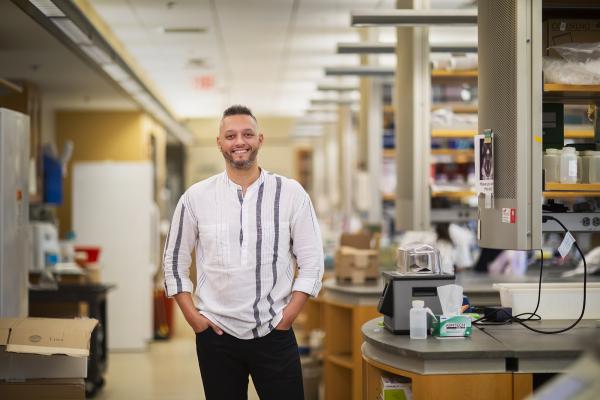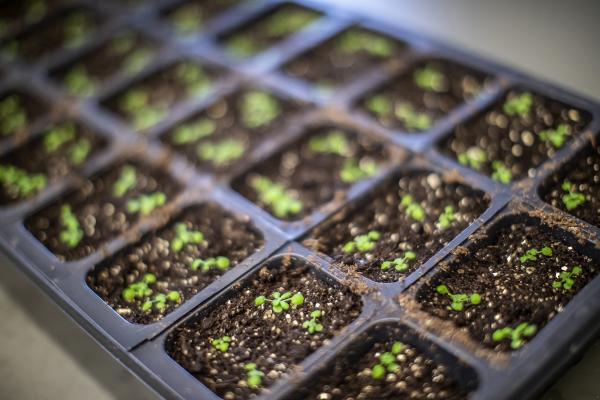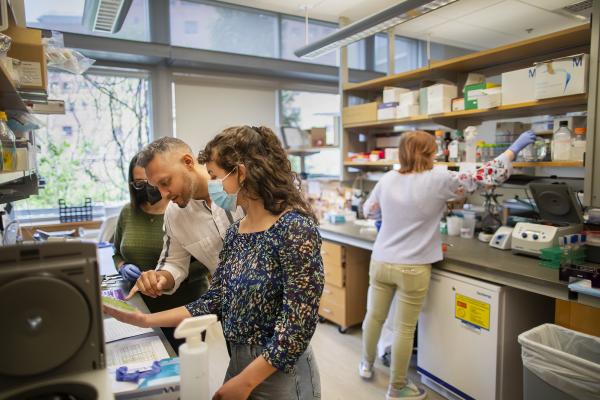
Nearly paper-thin, often with a complex two-dimensional shape, leaves may number into the hundreds of thousands on an organism like a white oak. Yet typically, each leaf appears quite similar in form.
How is it that a plant coordinates the production of these leaves, one after another, so carefully and so reproducibly?
The molecular forces governing this aspect of plant development are a focus of Aman Husbands, who joined Penn’s Biology Department faculty in the School of Arts & Sciences in January. Exploring proteins and protein families involved in different facets of plant growth, Husbands has identified key regulators that appear fundamental to biology, and not just plant biology.
His curiosity-driven research is not only illuminating the basic mechanisms responsible for why plants grow as they do but also has the potential to impact how plants stay resilient in the face of climate change. It may even shed light on aspects of development and disease in other species, humans included.
“You could break down the lab into complexity and reproducibility,” says Husbands, the Mitchell J. Blutt and Margo Krody Blutt Presidential Assistant Professor of Biology. “How do you create these beautiful, complex shapes? Biology should go wrong all the time, and yet it doesn’t. We’re interested in the mechanisms responsible.”
Drawn to plants
As a kid, Husbands, who grew up in Toronto, “wanted to be a marine biologist, like everyone,” he says. Around his second year at the University of Toronto, when he began taking more specialized science courses, another aspect of biology caught his attention.
“Plants, for some reason, I loved,” he says. “It was a system that I just intuitively understood.”

During his undergraduate years he worked with Nancy Dengler, whose lab group studies plant anatomy. Anatomy was also the focus of the lab he joined for his graduate work at the University of California, Riverside. But after a half a year he switched to join the lab of Patricia Springer, who “was asking really interesting questions about plant development, including how plants establish boundaries between their organs,” says Husbands. Springer gave him the freedom to explore the molecular aspects of plant development, and he began to ask questions about protein function.
His doctoral research focused on a family known as the LOB DOMAIN (LBD) genes, transcription factors that control how and when genes are turned on and off. “People assumed these were transcription factors but that had not been formally shown,” he says. Under the guidance of Harley Smith, another Riverside faculty member at the time, Husbands gained the molecular biology skillset to pursue those questions, identifying the binding site recognized by this protein family, which are specific to plants. “I’m still proud of that paper,” he says.
Moving back to the East Coast for his postdoctoral work, he joined the lab of Marja Timmermans at Cold Spring Harbor Laboratory in New York. With Timmermans, now at Germany’s University of Tübingen, Husbands began delving into a transcription factor complex that still makes up “the bread and butter” of his research today, known as the HD-ZIPIIIs. “What interested me about this family is that it’s very, very deeply conserved,” he says, its origins tracing back 750 million years or more in evolutionary time. HD-ZIPIII genes, if manipulated, impact multiple aspects of plant development, Husbands says, including stem cells, the plant vein system, and leaf architecture.
When leaf formation goes wrong
As Husbands moved from Cold Spring Harbor to a faculty position at Ohio State University, where he ran a lab for four years, and now to Penn, a question driving his work is, How can plants reliably churn out leaves that look the way they’re supposed to look? Plant biologists’ term for this is reproducibility or robustness, and Husbands studies it in the context of flat-leaf architecture, or the tendency of plants to consistently form “these paper-thin structures over and over again,” he says. “What makes this more compelling is that leaves don’t start out flat.” When they initially develop, they are ball-shaped, and only later flatten out into what most would recognize as a leaf: a thin form with a distinctive two-dimensional shape.
“It’s a very difficult process,” says Husbands. Plants usually get this right, but leaf growth occasionally goes awry. “You might get leaves curling up or down, which will lead to impacts on fitness,” he says.
Typically, however, Husbands says, “leaves always know, ‘This is my top; this is my bottom. I have a boundary from which to grow.’”
The concept of boundaries driving growth is not unique to plants but one that’s present in almost every developing organism. Thus, insights Husbands draws out in plants may have applications to other groups as well. “It’s a very classical developmental paradigm,” he says.
Other projects of Husbands involve collaborations with computational biologists and mathematicians. In one, he and colleagues are hoping to look for patterns in gene expression data in the hopes that new gene candidates will emerge as being central to the reproducibility and robustness of flat-leaf architecture.
Applications, partnerships, and inspiration
While Husbands is motivated by a love of basic science and discovery, he’s also moving his work into directions that might one day find real-world application. On the plant front, he notes that “engineering robustness,” by intervening with some of the transcription factors he’s studying, could enable plants to withstand the ups and downs of climate change. “We’re a ways away from that, but, if you could find a particular system that is susceptible to climate change, you could use these properties to basically shore it up, stabilize that biology and enable the plant to be resilient in the face of climate extremes.”

Going beyond plants, Husbands and his trainees are also investigating how the lipid binding domains they’ve studied in plants operate in proteins present across the tree of life, including a tumor suppressor protein present in humans. “We want to take knowledge from our work and others to develop strategies to affect activity of this tumor suppressor via this lipid-binding domain,” he says. “The therapeutic applications are obvious. If you develop a ligand to affect the activity of a tumor suppressor, you’re in business.”
With a department strong in plant biology as well as many other facets of science, and additional potential collaborators a stone’s throw away on campus, Husbands jumped at the opportunity to come to the Penn. “Penn is Penn,” he says. “During the recruitment process, just reading about what everyone was doing and their science—it’s just a firehose. You come away and you’re inspired.”

